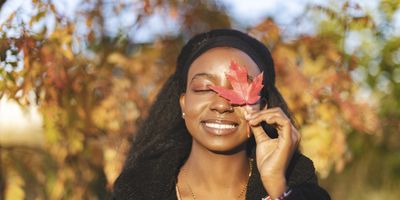Wellness
The fall and winter months are seasons that show a lot of promise. As the days gradually shorten and temperatures drop, it’s a time that offers space for fellowship and connection in spite of the noticeable gloominess. Still, it’s hard not to notice the profound impact that the lack of daylight can have on our daily routines, even down to our mood.
You know that feeling that comes as the weather and daylight shifts that makes you just want to hibernate until spring? Well, surprisingly enough, it’s quite natural to start feeling a bit down as the colder months roll in. The decrease in light exposure triggers changes in our biological clocks that can lead to disruptions in sleep patterns, affecting the production of mood-regulating hormones like serotonin and melatonin.
For many, the dwindling sunlight in fall can result in what’s known as “winter blues” or Seasonal Affective Disorder (SAD) that can cast a cloud over this otherwise vibrant season.
What Is Seasonal Depression?
Seasonal Affective Disorder is a form of depression also known as “seasonal depression or winter depression.” Those with SAD can see changes in their mood and symptoms that are similar to depression and tend to show symptoms during the fall and winter months due to the lack of sunlight.
“Individuals with SAD might experience more intense sadness and social withdrawal during periods of time in the fall and winter months,” Dr. Chanda Reynolds, Licensed Clinical Psychologist and host of the Paging Dr. Chanda podcast, tells xoNecole.
“Since other types of depression are a bit more pervasive, and the symptoms are more consistent across seasons, it's not as impacted by that seasonal piece, whereas SAD is.”
JulPo/Getty Images
Recognizing the Common Symptoms of SAD
SAD is predictable in its nature as it typically arrives and departs with the changing seasons — from late fall to early spring. And while the signs of SAD run parallel to those of other types of depression, one tell-tale sign that you might be experiencing SAD is when the dip in your overall mood and mental health shifts.
“If you’re feeling sad more days than not, experiencing changes in your appetite and sleep patterns. Showing symptoms of fatigue — like always feeling exhausted no matter how much rest you get — or having a loss of interests and things that you once found pleasurable,” Dr. Chanda says. “These are all things that one might experience with major depressive disorder, but it's different if it’s more within those fall and winter months.”
Light Therapy for Managing SAD
“One of the things that causes SAD is the lack of light exposure,” Dr. Chanda states. “When we're out in the sun, we're able to absorb the rays from the sun that produce vitamin D, which produce different neurotransmitters in the body that induce happiness; we're then able to feel a steadiness in our mood and joy. But if that's not happening because we're not getting as much sunlight exposure, our mood is going to go down.”
Light therapy is a helpful treatment to alleviate the symptoms of SAD as it exposes you to a bright light that mimics natural sunlight. “You're exposing yourself to light so that you can receive more vitamin D,” she explains. “It's really important for Black people too. Since we're melanated individuals, Black people are less likely to have that vitamin D in our skin that allows us to produce the different neurotransmitters that are needed from the sun when we have exposure to sunlight.”
JulPo/Getty Images
Boost Your Mood: Leaning on Community for SAD Relief
If you think you might be dealing with SAD, it’s important to take advantage of the sunlight that you do have in the day and lean on your community in order to beat the winter blues.
“That might mean taking a walk to go get your lunch during the day or waking up earlier and taking a walk outside," Dr. Chanda advises. “Whatever we need to do, take advantage of the sunlight that we have while we have it.”
Asking for help and support can be hard, but as Dr. Chanda says, being open and transparent about your needs can pay off in the end.
“Letting others know about what you need can be so helpful and rewarding to the people around you. Because the fact of the matter is people are reluctant to share when they need support because they feel like other people don't care. But there are people around who care, there are people around who want to know how you're doing and what you're experiencing.”
Let’s make things inbox official! Sign up for the xoNecole newsletter for daily love, wellness, career, and exclusive content delivered straight to your inbox.
Featured image by JulPo/Getty Images
ALSO ON XONECOLE
